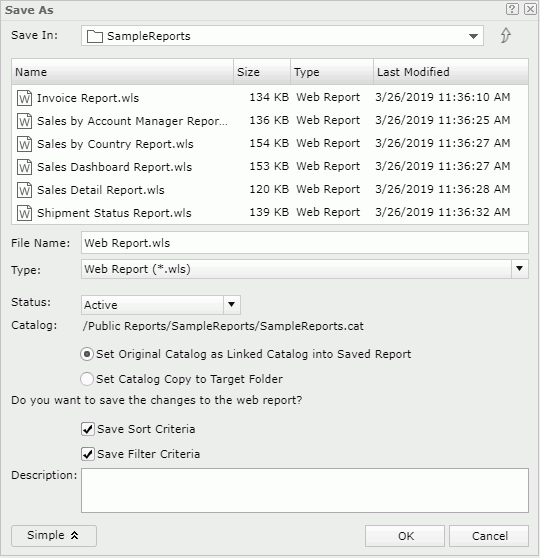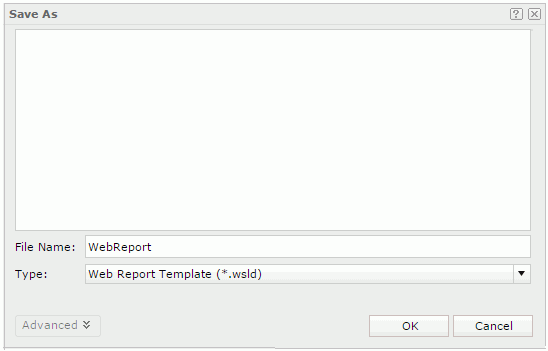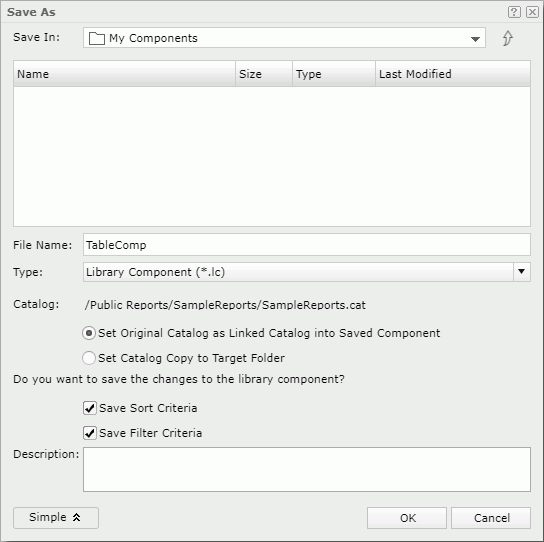Save As Dialog Box Properties
This topic describes how you can use the Save As dialog box to save the current web report or the web report page template, or save a data component in the current web report as a library component. The dialog box varies for different purposes.
To use the Save As dialog box to save the current web report, select Menu > File > Save As or the Save As button  on the toolbar, or select Save in the Web Report Wizard. In this case Server displays the dialog box as follows:
on the toolbar, or select Save in the Web Report Wizard. In this case Server displays the dialog box as follows:

Save In
Specifies the directory in the server resource tree where you want to save the report. Use the button  to go to the parent folder. The root folder cannot be used to store resources.
to go to the parent folder. The root folder cannot be used to store resources.
The resource table shows the resources in the current directory. You can select the column names to change the order of the resources in the table list.
- Name
Displays the resource names. - Size
Displays the size of the resources. - Type
Displays the resource types. - Last Modified
Displays the last modified time of the resources.
File Name
Specifies the name for the report.
Type
It is Web Report by default.
Advanced/Simple
Displays or hides the advanced settings.
- Status
Specifies the status of the report.- Active
The report can be executed. To execute a report means to run, advanced run and schedule to run it. - Inactive
The report cannot be executed. If selected, the corresponding Run, Advanced Run and Schedule commands for the report are not available. - Incomplete
The report is not completely designed and cannot be executed. If selected, the corresponding Run, Advanced Run and Schedule commands for the report are not available.
- Active
- Catalog
Specifies the catalog that the report uses.- Set Original Catalog as Linked Catalog into Saved Report
If the option is selected, the saved report will be linked with the catalog and will run with the catalog no matter whether the two are in the same directory. If later the catalog is updated, the report will run with the latest version of the catalog. - Set Catalog Copy to Target Folder
If the option is selected, the catalog will be copied to the directory where the report is saved, and the saved report will run with the copied catalog.
- Set Original Catalog as Linked Catalog into Saved Report
- Save Sort Criteria
Specifies whether to save the changes made by sorting. - Save Filter Criteria
Specifies whether to save the changes made by filtering. - Description
Specifies the description for the report.
OK
Saves the report with the specified settings and closes this dialog box.
Cancel
Does not save the report and closes the dialog box.

Displays the help document about this feature.

Ignores the setting and closes this dialog box.
If you are an admin user with the privilege of publishing resources, you are able to see the option Web Report Template from the Type drop-down list of the Save As dialog box. By selecting the option you can save the page template the web report uses.
When you use the Save As dialog box to save a web report page template, it appears as follows:

Template box
Lists the existing web report page templates.
File Name
Specifies the name of the web report page template. You can type the name to save it as a new template (.wsld) or select one from the template box above to overwrite an existing template according to the Publish privilege, which is the system level authorization.
Type
Select Web Report Template from the drop-down list. The option Web Report Template is available to administrators with the privilege of publishing resources.
OK
Saves the web report page template with the specified settings and closes this dialog box.
Cancel
Does not save the web report page template and closes the dialog box.

Displays the help document about this feature.

Ignores the setting and closes this dialog box.
To use the dialog box to save a data component in a web report as a library component, right-click a table, crosstab, chart, KPI, or geographic map and select Save as Library Component. In this case Server displays the dialog box as follows:

Save In
Specifies the directory in the server resource tree where you want to save the library component. Use the button  to go to the parent folder. The root folder cannot be used to store resources.
to go to the parent folder. The root folder cannot be used to store resources.
The resource table shows the resources in the current directory. You can select the column names to change the order of the resources in the table list.
- Name
Displays the resource names. - Size
Displays the size of the resources. - Type
Displays the resource types. - Last Modified
Displays the last modified time of the resources.
File Name
Specifies the name for the library component.
Type
It is Library Component by default which cannot be changed.
Advanced/Simple
Displays or hides the advanced settings.
- Catalog
Specifies the catalog that the library component uses.- Set Original Catalog as Linked Catalog into Saved Component
If the option is selected, the saved library component will be linked with the catalog and will run with the catalog no matter whether the two are in the same directory. If later the catalog is updated, the library component will run with the latest version of the catalog. - Set Catalog Copy to Target Folder
If the option is selected, the catalog will be copied to the directory where the library component is saved, and the library component will run with the copied catalog.
- Set Original Catalog as Linked Catalog into Saved Component
- Save Sort Criteria
Specifies whether to save the changes made by sorting. - Save Filter Criteria
Specifies whether to save the changes made by filtering. - Description
Specifies the description for the library component.
OK
Saves the library component with the specified settings and closes this dialog box.
Cancel
Does not save the library component and closes the dialog box.

Displays the help document about this feature.

Ignores the setting and closes this dialog box.
 Previous Topic
Previous Topic